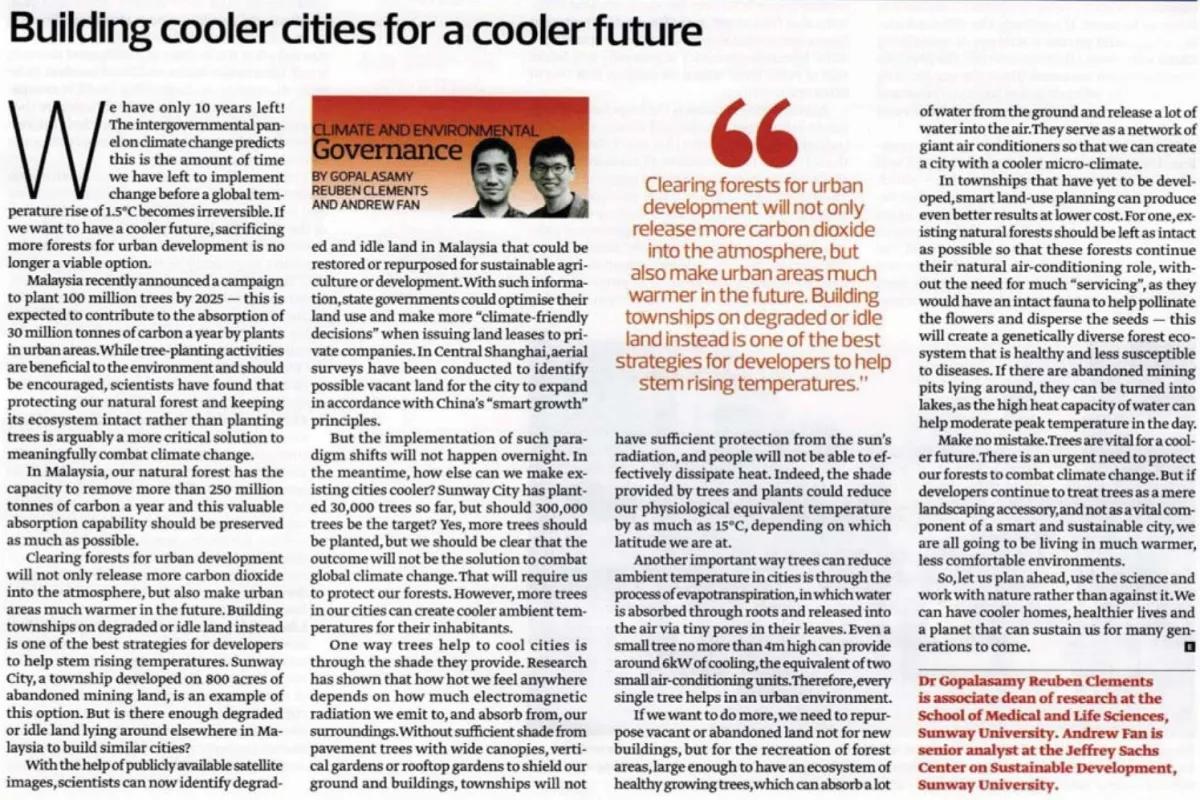Climate and Environmental Governance: Building Cooler Cities for a Cooler Future
We have only 10 years left! The intergovernmental panel on climate change predicts this is the amount of time we have left to implement change before a global temperature rise of 1.5°C becomes irreversible. If we want to have a cooler future, sacrificing more forests for urban development is no longer a viable option.
Malaysia recently announced a campaign to plant 100 million trees by 2025 — this is expected to contribute to the absorption of 30 million tonnes of carbon a year by plants in urban areas. While tree-planting activities are beneficial to the environment and should be encouraged, scientists have found that protecting our natural forest and keeping its ecosystem intact rather than planting trees is arguably a more critical solution to meaningfully combat climate change.
In Malaysia, our natural forest has the capacity to remove more than 250 million tonnes of carbon a year and this valuable absorption capability should be preserved as much as possible.
Clearing forests for urban development will not only release more carbon dioxide into the atmosphere, but also make urban areas much warmer in the future. Building townships on degraded or idle land instead is one of the best strategies for developers to help stem rising temperatures. Sunway City, a township developed on 800 acres of abandoned mining land, is an example of this option. But is there enough degraded or idle land lying around elsewhere in Malaysia to build similar cities?
With the help of publicly available satellite images, scientists can now identify degraded and idle land in Malaysia that could be restored or repurposed for sustainable agriculture or development. With such information, state governments could optimise their land use and make more “climate-friendly decisions” when issuing land leases to private companies. In Central Shanghai, aerial surveys have been conducted to identify possible vacant land for the city to expand in accordance with China’s “smart growth” principles.
But the implementation of such paradigm shifts will not happen overnight. In the meantime, how else can we make existing cities cooler? Sunway City has planted 30,000 trees so far, but should 300,000 trees be the target? Yes, more trees should be planted, but we should be clear that the outcome will not be the solution to combat global climate change. That will require us to protect our forests. However, more trees in our cities can create cooler ambient temperatures for their inhabitants.
One way trees help to cool cities is through the shade they provide. Research has shown that how hot we feel anywhere depends on how much electromagnetic radiation we emit to, and absorb from, our surroundings. Without sufficient shade from pavement trees with wide canopies, vertical gardens or rooftop gardens to shield our ground and buildings, townships will not have sufficient protection from the sun’s radiation, and people will not be able to effectively dissipate heat. Indeed, the shade provided by trees and plants could reduce our physiological equivalent temperature by as much as 15°C, depending on which latitude we are at.
Another important way trees can reduce ambient temperature in cities is through the process of evapotranspiration, in which water is absorbed through roots and released into the air via tiny pores in their leaves. Even a small tree no more than 4m high can provide around 6kW of cooling, the equivalent of two small air-conditioning units. Therefore, every single tree helps in an urban environment.
If we want to do more, we need to repurpose vacant or abandoned land not for new buildings, but for the recreation of forest areas, large enough to have an ecosystem of healthy growing trees, which can absorb a lot of water from the ground and release a lot of water into the air. They serve as a network of giant air conditioners so that we can create a city with a cooler micro-climate.
In townships that have yet to be developed, smart land-use planning can produce even better results at lower cost. For one, existing natural forests should be left as intact as possible so that these forests continue their natural air-conditioning role, without the need for much “servicing”, as they would have an intact fauna to help pollinate the flowers and disperse the seeds — this will create a genetically diverse forest ecosystem that is healthy and less susceptible to diseases. If there are abandoned mining pits lying around, they can be turned into lakes, as the high heat capacity of water can help moderate peak temperature in the day.
Make no mistake. Trees are vital for a cooler future. There is an urgent need to protect our forests to combat climate change. But if developers continue to treat trees as a mere landscaping accessory, and not as a vital component of a smart and sustainable city, we are all going to be living in much warmer, less comfortable environments.
So, let us plan ahead, use the science and work with nature rather than against it. We can have cooler homes, healthier lives and a planet that can sustain us for many generations to come.
This article first appeared in Forum, The Edge Malaysia Weekly, on February 15 - 22, 2021.




